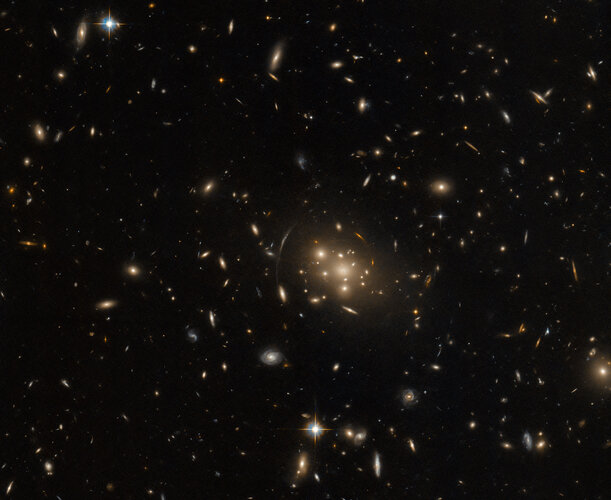A massive galaxy cluster in the constellation Cetus dominates the centre of this image from the NASA/ESA Hubble Space Telescope. This image is populated with a serene collection of elliptical and spiral galaxies, but galaxies surrounding the central cluster — which is named SPT-CL J0019-2026 — appear stretched into bright arcs, as if distorted by a gargantuan magnifying glass. This cosmic contortion is called gravitational lensing, and it occurs when a massive object like a galaxy cluster has a sufficiently powerful gravitational field to distort and magnify the light from background objects. Gravitational lenses magnify light from objects that would usually be too distant and faint to observe, and so these lenses can extend Hubble’s view even deeper into the Universe.
This observation is part of an ongoing project to fill short gaps in Hubble’s observing schedule by systematically exploring the most massive galaxy clusters in the distant Universe, in the hopes of identifying promising targets for further study with both Hubble and the NASA/ESA/CSA James Webb Space Telescope. This particular galaxy cluster lies at a vast distance of 4.6 billion light years from Earth.
Each year, the Space Telescope Science Institute is inundated with observing proposals for Hubble, in which astronomers suggest targets for observation. Even after selecting only the very best proposals, scheduling observations of all of Hubble’s targets for a year is a formidable task. There is sometimes a small fraction of observing time left unused in Hubble’s schedule, so in its ‘spare time’ the telescope has a collection of objects to explore — including the lensing galaxy cluster shown in this image.
[Image description: A cluster of large galaxies, surrounded by various stars and smaller galaxies on a dark background. The central cluster is mostly made of bright elliptical galaxies that are surrounded by a warm glow. Nearby the cluster is the stretched, distorted arc of a galaxy, gravitationally lensed by the cluster.]



 Image:
Cosmic contortions
Image:
Cosmic contortions